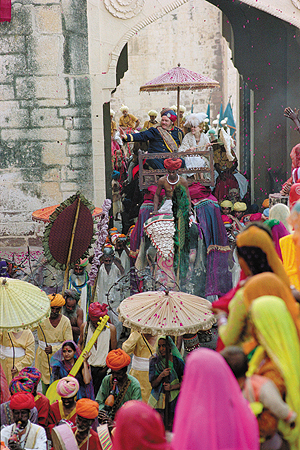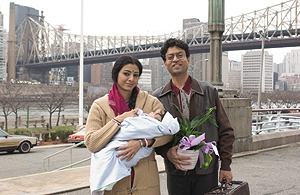BY JESSICA WINTER
 Photo by Patrick Harbron
Photo by Patrick Harbron"The first thing I do in rehearsals is create an environment in which we can all make fools of ourselves," says Mira Nair with a smile. "We must take risks and make jokes and feel comfortable, because that's our privilege at that moment before we discover what it is we must shoot."
Perhaps that explains why the films of the Indian-born director achieve a captivating mix of colorful spectacle and improvisatory energy, from her first feature, Salaam Bombay!, which cast non-professional actors from Bombay's mean streets, to her latest, The Namesake, a cross-cultural tale based on Jhumpa Lahiri's 2003 bestseller. Since her award-winning breakthrough in 1988, Nair has made it her trademark to dramatize conflicts between generations and customs, with a particular interest in newcomers to America, a subject she knows firsthand.
Nair was 19 when she came to America on a scholarship to study theater at Harvard in the late '70s. "But the theater at Harvard at that time was very uninspired, apolitical," she recalls. "I chose the next best thing, which was documentary filmmaking. I was lucky enough to study with [British documentary innovator] Richard Leacock. I discovered that cinema vérité was a way to capture subjects that got under my skin–the street, with all its chaos, has always been the stuff of my inspiration, especially in India.
But finding an audience for her films was hard and lonely. "Documentaries were virtually unknown in India then. It was the struggle to find a bigger audience that led me to make fiction. I was losing my patience [with documentaries]–I wanted to control the gesture, the story, the light. In documentary, you find the narrative in the editing room; I like to know what the story is going to be before I start."
The idea for Salaam Bombay!, which was nominated for an Academy Award for Best Foreign Language film, was born on the street, an extension of her documentary training. It follows the life of a 12-year-old boy and his friends as they eke out an existence in the city. Because Salaam Bombay! was partially financed by grants from the Indian government, Nair was allowed into care homes and rehabilitation centers where she discovered her story. Shooting entirely on location, sometimes with concealed cameras, Nair says, "I found that I could create heightened fiction in a documentary context."
 STREETWISE: Mira Nair has displayed an eye for life on the street in films
STREETWISE: Mira Nair has displayed an eye for life on the street in films
such as Vanity Fair with Reese Witherspoon. (Credit: Patrick Harbron)Having learned her craft under strained conditions with limited means, Nair forged a resourceful style of shooting that informs her work even today. "I've never had the luxury of excess time or money, so I'm very well-planned, and usually there's no scrambling, unless it's weather-related," says Nair, who had a mad rush to catch the last snowfall of the year in Yonkers for The Namesake.
The Namesake reaches between two countries over three decades to chronicle the bittersweet journey of Ashoke (Irfan Khan) and his wife Ashima (Tabu), Bengali immigrants to Yonkers, and their American-born son with the odd but significant name, Gogol (Kal Penn of Harold and Kumar Go to White Castle).
It's a more intimate story than Nair's previous work such as the multi-thread melodrama Monsoon Wedding or her expeditious take on Thackeray in Vanity Fair. The Namesake "is inspired by grief," Nair says, "but I never wanted to belabor a mood or have chest-beating. More than the book did, I wanted to maximize the love story of Ashoke and Ashima," she explains.
Although the couple is the product of an arranged marriage, Nair wanted to avoid the clichés of clashing cultures. "It would be so uninteresting just to present the mail-order bride, the traditional, demure girl who accepts her fate. I refuse to go there. In the book, when Ashima steps into Ashoke's shoes, it's such a great moment for a filmmaker. But when we were shooting it, I had her lift up her sari and pose as if she is the master of her world. Each scene between Ashoke and Ashima had to take their relationship to a different level of sensuality and tenderness, and depth, and then abject pain. But there isn't that much time to do it."
One of the challenges of adapting the book was figuring out how to tell a story that extends over 30 years in shorthand. "I had to distill almost everything within a moment to do justice to the whole cornucopia of the story, the traveling between these two worlds, growing up, first love, nostalgia, exile."
Visually, Nair had a clear strategy for how to freeze the tale's potent moments in time. "It was clear to me from the beginning that, unlike Monsoon Wedding, The Namesake would not use a moving camera, but rather unfold like a sequence of classical photographs," she says, relaxing on a couch in her bright office near New York's Union Square. "I wanted either a series of stills, with actors moving within the frame, or single-take masters. It was important to establish a deliberate pace, especially in the beginning of the film when we're in the Old World, until New York hits and the pace gets faster."
For some flashback scenes, Nair and her cinematographer, Frederick Elmes, used bleach bypass to infuse the image with an eerie intensity, "but only when the emotional recall of the scene was harsh," she adds.
 BRIDGING THE GAP: Irfan Khan (right) and Tabu are Bengali immigrants
BRIDGING THE GAP: Irfan Khan (right) and Tabu are Bengali immigrants
in New York in Nair's latest, The Namesake. (Photo Credit: Focus Features)Director and DP also shared a real harmony on the visual quality that Nair was aiming for, which was to film Calcutta and New York as if they were the same city, from the bridges to the graffiti to the layering of the streets. "I wanted the audience to know that seesaw feeling of the immigrant who doesn't quite understand where she is. Outside your window, you could be seeing the Howrah Bridge in Calcutta or the George Washington Bridge in New York. I've lived in both cities for most of my life, and I feel such a commonality of energies between them."
On a performance level, getting the right tone was a matter of trial and error for Nair. "Ashoke needed to have an interiority: not much talk, not much display of emotion, not much physicality, but everything is inside, quietly and deeply." To get to that point, Nair improvised during rehearsals to pare dialogue down. "My big thing is to keep it as non-verbal as possible, to keep the dialogue quite spare. Generally, though, by the time you get to the shooting stage, we have it sussed."
Combining cultures as she does in her films, Nair has found a way to bring her Eastern sensibility to the set. "We do yoga for an hour and 15 minutes before shooting every morning," she says. "It's the first thing on the call sheet. It's completely voluntary, but there are 15 of us hardcore types who will be there wherever we can find space on a location–whether it's a back room or a bar. It irons us out, and creates this atmosphere of calm and focus. There are no tantrums on my sets, no raised voices. Someone was telling me recently how amazed they were that one could do so much work so silently."